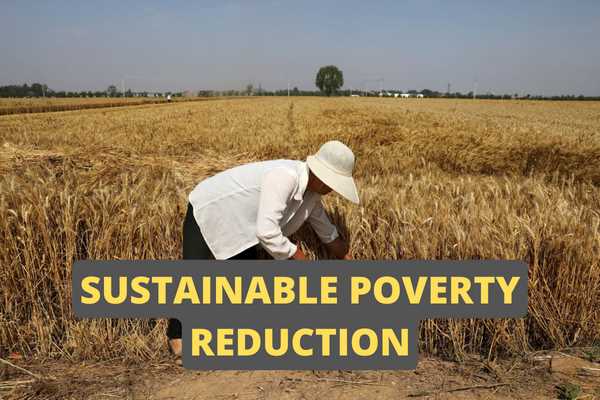Guidelines to evaluate the implementation of the National Target Program on Sustainable Poverty Reduction for the period of 2021 - 2025?
- Purposes of evaluating the implementation of the National Target Program on Sustainable Poverty Reduction in the 2021-2025 period?
- Content of evaluating the implementation of the National Target Program on Sustainable Poverty Reduction in the 2021-2025 period?
- Steps to evaluate the implementation of the National Target Program on Sustainable Poverty Reduction in the 2021-2025 period?
Purposes of evaluating the implementation of the National Target Program on Sustainable Poverty Reduction in the 2021-2025 period?
According to subsection 1, Section II of Circular 10/2022/TT-BLDTBXH stipulating the purposes of evaluating the implementation of the National Target Program on Sustainable Poverty Reduction in the 2021-2025 period:
- Determine the level of achievement according to specific goals and targets compared with investment decisions or evaluation standards prescribed by the state at a certain time.
Content of evaluating the implementation of the National Target Program on Sustainable Poverty Reduction in the 2021-2025 period?
According to subsection 2, Section II of Circular 10/2022/TT-BLDTBXH stipulating the content of assessment of the implementation of the National Target Program on Sustainable Poverty Reduction in the 2021-2025 period:
(a) Contents of the annual assessment
- Evaluation of program management in the year of implementation, including:
+ Results of developing management policies, organizing and implementing the program; coordination and coordination in management and implementation; communication, information and program monitoring, supervision and evaluation activities; the observance of the supervision regime of the elected bodies.
+ Status of capital mobilization, allocation and use.
+ The level of achievement of the results of the implementation of the goals and tasks compared with the annual plan and the 5-year period assigned by the competent authority.
+ Existence, arising problems and causes.
+ Orientations and solutions for the next year.
(b) Content of the midterm evaluation of the program
- Evaluation of program management, including:
+ Results of developing management policies, organizing and implementing the program; administration and coordination in program management and organization; communication, information and program monitoring, supervision and evaluation activities; the observance of the supervision regime of the elected bodies.
+ Status of capital mobilization, allocation and use.
+ The results of the implementation of the objectives and tasks include: The conformity of the results of the program implementation with the program objectives approved by the competent authorities; the degree of completion of program objectives and tasks up to the time of evaluation compared with the 5-year plan period.
Existence, limitations and causes.
+ Proposing solutions to implement the program from the time of evaluation to the last year of the 5-year period, including proposals for program adjustment (if any).
(c) Content of the program end evaluation:
- Evaluation of program management, including:
+ Result of developing a system of management policies and organization of implementation; administration and coordination in management and implementation; communication, information and program monitoring, supervision and evaluation activities; the observance of the supervision regime of the elected bodies.
- Evaluate the results of capital mobilization, allocation and use.
- Evaluating the results of the implementation of the program's specific goals, targets and tasks in comparison with those approved by competent authorities.
- Assess the impact and effectiveness of the program's investment on socio-economic development; program sustainability; gender equality; environment, ecology (if any).
- Lessons learned from the program implementation and recommendations needed to maintain the program's results; measures to minimize negative social and environmental impacts (if any).
(d) Unscheduled evaluation of the program:
- The content of the unexpected assessment shall comply with the provisions of Point a, Clause 2, Section II of this Appendix.
- Identify unexpected arisings (if any), unexpected causes and responsibilities of relevant agencies, organizations and individuals; the impact of the arising on the implementation of the program, the ability to accomplish the goals of the program.

Guidelines to evaluate the implementation of the National Target Program on Sustainable Poverty Reduction for the period of 2021 - 2025?
Steps to evaluate the implementation of the National Target Program on Sustainable Poverty Reduction in the 2021-2025 period?
According to subsection 3, Section II, Circular 10/2022/TT-BLDTBXH stipulating the steps to evaluate the implementation of the National Target Program on Sustainable Poverty Reduction in the 2021-2025 period:
(a) Collecting information and reporting at the commune level The Commune People's Committee directs the Commune Management Board to:
- Periodically collect information according to Schedules 03, 04, 05, 06, 07, 08, 09, 10, 11, 11 and 12 13, Schedule 14, Table 15.
+ For the forms from Tables 04 to 15, periodically collected in the beneficiary communes of projects and sub-projects, the contents of components of the Program are directly invested or implemented by the commune level. presently.
- Prepare 6-monthly, annual monitoring report (Form No. 01), Evaluation report at the beginning, mid-term, end and annual, ad-hoc (Form 02) and send it to District-level National Target Program Steering Committee (through the Department of Labor, War Invalids and Social Affairs) and direct management departments and divisions.
- Update information on the management system of the national target program for sustainable poverty reduction according to regulations.
(b) Information collection, synthesis, reporting at district level
- The relevant agencies and units collect information in Table 06, Table 07, Table 11, Table 12, Table 14, Table 15 (about projects, sub-projects, content of components issued by the granting authority). directly implemented by the district).
- Relevant agencies and units shall synthesize report forms according to projects, sub-projects, component content assigned to lead, manage and implement; develop a 6-month, annual monitoring report (Form No. 01) for projects, sub-projects and component content managed by the department, and evaluation reports at the beginning, mid-term, end and annual annually, irregularly (Form No. 02) and send it to the Steering Committee of National Target Programs at district level (via the Department of Labor - Invalids and Social Affairs) and departments and branches directly managing the Division of Labor - Invalids and Social Affairs. and Society generalizes Tables 03, 04, 05, 06, 07, 08, 09, 10, 11, 11, 12, 13. , Schedule 14, Schedule 15, and at the same time synthesize Tables 01 and 02; develop a 6-month, annual monitoring report (Form No. 01), an evaluation report of the beginning, mid-term, end and annual, unexpected (Form No. 02) to report to the People's Committee of the district, the Department Labor - Invalids and Social Affairs and departments, agencies and sectors shall assume the prime responsibility for, manage and implement projects, sub-projects and components of the Program. Update information on the management system of the national target program for sustainable poverty reduction according to regulations.
(c) Consolidation and reporting at the provincial level
- The relevant agencies and units collect information in Table 06, Table 07, Table 11, Table 12, Table 14, Table 15 (about projects, sub-projects, content of components issued by the granting authority). directly implemented by the province).
- Relevant agencies and units shall synthesize report forms according to projects, sub-projects, component content assigned to lead, manage and implement; develop a 6-month, annual monitoring report (Form No. 01) for projects, sub-projects and component content managed by departments and agencies, and evaluation reports at the beginning, middle, and end of the period. and annually, irregularly (Form No. 02) and send it to the Department of Labor, War Invalids and Social Affairs and the ministries and branches for direct management.
- The Department of Labor - Invalids and Social Affairs generalizes the Tables 03, 04, 05, 06, 07, 08, 09, 10, and 11, Schedule 12, Table 13, Schedule 14, and Table 15, and at the same time synthesize Tables 01 and 02; develop a 6-month, annual monitoring report (Form No. 01), an evaluation report of the beginning, mid-term, end and annual, extraordinary (Form No. 02) to report to the Provincial People's Committee and the Ministry of Finance, Labor - Invalids and Social Affairs. Update information on the management system of the national target program for sustainable poverty reduction according to regulations.
d) Synthesize and report at central level
- Relevant ministries and central agencies collect information in Table 06, Table 07, Table 11, Table 12, Table 14, Table 15 (about projects, sub-projects, components of the project) directly implemented at central level).
- Ministries and central agencies shall assume the prime responsibility for, manage, and implement projects and sub-projects, with components of the 6-monthly, annual monitoring report (Form No. 01), and the beginning-of-term evaluation report. , midterm, end and annual, ad hoc (Form No. 02) and send it to the Ministry of Labor, War Invalids and Social Affairs, the Ministry of Planning and Investment, and the Ministry of Finance.
- The Ministry of Labor, War Invalids and Social Affairs summarizes the 6-monthly, annual supervision report (Form 01), the report of the early, mid-term, end and annual, ad-hoc evaluation (Form 02); update information on the management system of the national target program for sustainable poverty reduction according to regulations, send it to the Ministry of Planning and Investment, the Ministry of Finance and report to the Central Steering Committee for national target programs, Government, Prime Minister.
Circular 10/2022/TT-BLDTBXH comes into force from 15/07/2022.
LawNet
